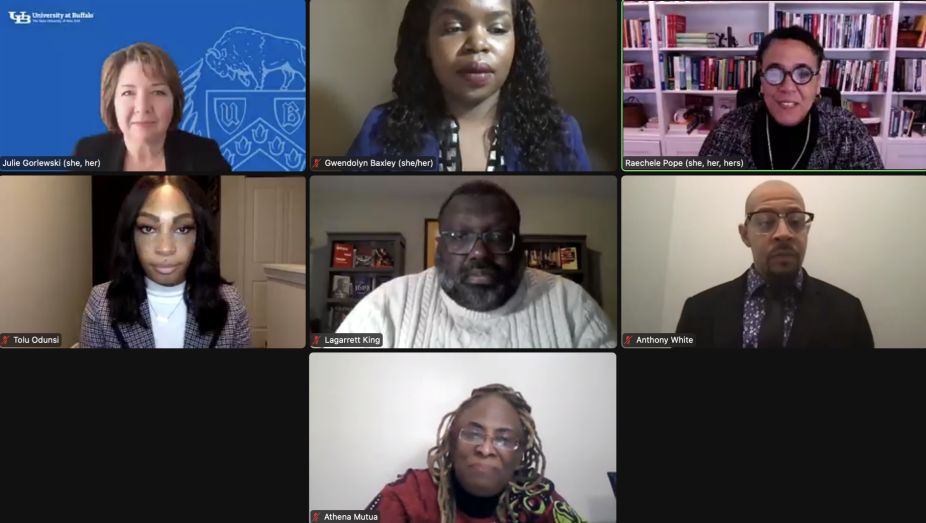
GSE panel discussion clarifies the conversation about critical race theory
BY DANIELLE LEGARE
As debate and misinformation about critical race theory spread across the nation, the Graduate School of Education and the School of Law held a virtual panel on Feb. 25 to shed light on the current public discourse concerning this academic concept.
The panel, “Critical Race Theory: Clarifying the Conversation,” was organized by GSE’s standing committee for Equity, Diversity, Justice and Inclusion. The event was open to the public and drew about 350 people.
In her opening remarks, Raechele Pope, GSE senior associate dean for faculty and student affairs and chief diversity officer, explained: “Recently, critical race theory has become a target of political activism, leading to significant confusion about what critical race theory is and what role, if any, it plays in education. This coordinated effort against critical race theory has led legislatures in many states to ban CRT and prohibit and sanction teaching about racism and the racial history of the U.S.”
Julie Gorlewski, professor and chair of the Department of Learning and Instruction, moderated the event. The panelists included:
- Gwendolyn Baxley, assistant professor of educational leadership and policy
- LaGarrett King, associate professor of learning and instruction, and director of UB’s Center for K-12 Black History and Racial Literacy Education
- Athena D. Mutua, professor of law and Floyd H. and Hilda L. Hurst Faculty Scholar
- Tolulope F. Odunsi, lecturer in law
- Anthony L. White II, social studies teacher at PS #31 Harriet Ross Tubman School, and GSE doctoral student and instructor in learning and instruction
Throughout the 90-minute event, the faculty experts exchanged views on the current conversations and state legislation focused on critical race theory in education.
My hope is that the dialogue will continue in ways that promote equity and diversity, justice and inclusion through the power of public education." — Julie Gorlewski, PhD
“What we’ve begun to see is not only the banning of CRT, but the banning of critical teaching methods more generally, and especially those centered on issues of race and racism—and I think this is dangerous,” said White. “It’s dangerous for the development of our students who will be the social and political actors and leaders of our nation and future, and it’s dangerous for the well-being of our society as a whole.”
Baxley agreed and added that these bans are intentional strategies to suppress the truth and maintain and retain control by dominant groups.
“One point I am going to clarify around this conversation is this notion that we are indoctrinating students when we talk about race, racism and anti-Blackness. I find that young people are already making meaning of their experiences, making meaning of structures of oppression and privilege and power inside of school but also outside of school, and they are using mediums such as TikTok, Snapchat and Twitter, and leveraging memes and gifs, to understand and analyze their experiences,” Baxley said. “Young people are engaging in this kind of reflection in other spaces outside of schools, leveraging their own agency, leveraging their own political consciousness and using other methods to explore these areas.”
The group advanced the conversation by considering how the fields of law and education can work together to meet the challenges our country faces regarding how we teach and learn about race and racism in K-12 schools.
One of White’s suggestions: “I think that at least some coursework in law and policy analysis, including from a critical perspective, should be a requirement in every teacher education program because teachers are going to have to be impacted by and beholden to legislation.”
As the discussion concluded, Gorlewski ended the event with a note of optimism. “My hope is that the dialogue will continue in ways that promote equity and diversity, justice and inclusion through the power of public education,” she said.